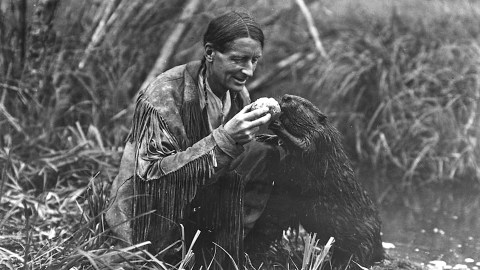
Meet the masterful con-men who impressed the great and the good despite the astonishing fiction of their very existence.
KEY TAKEAWAYS
- Occasionally the actions of charlatans have unintended consequences that lead to great things.
- Faux-Tibetan abbot Tuesday Lobsang Rampa was lauded by the Dalai Lama but was actually an English plumber named Cyril.
- Archibald Belaney — who passed himself off as a Native American called Grey Owl — became a hugely influential and pioneering conservationist.
Excerpted from The Theory of Everything Else by Dan Schreiber. Copyright © 2022 by Dan Schreiber. Reprinted courtesy of William Morrow, an imprint of HarperCollins Publishers.
Charlatans fascinate me. Though mostly incredibly dangerous characters, the unintended consequences of their actions sometimes lead to great things, for which they are often never given credit. Don’t get me wrong, though, few things give me greater pleasure than seeing a charlatan exposed, like the English occultist and High Priest of Wicca Alex Sanders (1926-88), the self-styled “King of the Witches” no less, and also known as Verbius. Sanders was exposed for conning his followers when he took members of the press to Alderley Edge in Cheshire to raise a man from the dead using an ancient summoning. The successful stunt propelled Sanders to fame. However, years later, his ex-wife revealed that, not only did he not resurrect the man, but the summoning itself was just a Swiss roll recipe read backwards. I do sometimes wonder where we’d be without them though.
Take Tuesday Lobsang Rampa (1910-81), who has been called the greatest hoaxer that the field of Tibetan studies has ever known. Apparently the son of an aristocrat who worked for the Dalai Lama’s government, Rampa was recognized as an incarnated Tibetan abbot and medical lama. He grew up in Lhasa, where he was looked after by Old Tzu, a seven-foot-tall retired monk policeman, and he later authored many bestselling books including The Third Eye, which sold half a million copies, and Living with the Lama, which was dictated to him by his cat, Mrs. Fifi Greywhiskers.
“Everything Dr. Rampa wrote is 100 per cent true,” says his website to this day. However, Heinrich Harrer, the legendary Austrian mountaineer, former Waffen-SS soldier, ice-rink builder to the Dalai Lama, and author of Seven Years in Tibet, didn’t agree and took it upon himself to out Rampa as a fraudster. His findings were shocking. Harrer discovered that Rampa had never been to Tibet, didn’t speak any Tibetan, and was actually a plumber from Plympton, Devon, whose real name was Cyril Henry Hoskin.
Rather than admitting to conning the public, Rampa wrote another book to explain himself titled The Rampa Story, in which he admitted that, yes, he used to be Cyril Hoskin, but he stopped being Hoskin after falling out of a tree as he was trying to photograph an owl. While he lay on the ground, the spirit of a monk sidled up to him and offered to switch bodies. Hoskin then assumed the soul of the monk.
Interestingly, despite all of this conning, Rampa was an incredibly influential figure. American Tibetanologist Donald S. Lopez Jr. discovered, when mentioning Rampa’s bestselling books to his contemporaries, that several cited Rampa as being the person who introduced them to and got them obsessed with the subject of Tibet. Despite being a total fraud, he was thanked for his work by many, including the Dalai Lama.
Then there was Grey Owl (1888-1938), a Native American conservationist who first came to global fame with the publication of his 1931 memoir The Men of the Last Frontier, which attracted rave reviews and made him an international star. It tells the story of his life, from his birth in Rio Grande to a New Mexico Apache Indian mother and Scottish father, both of whom were performers for Buffalo Bill’s Wild West Show (Grey Owl would later serve as a knife-thrower in this same show), to his studies under Ojibwa chief Ne-Ganikabo, and his attempts at conservation, most notably in trying to conserve beavers. The book comes with a foreword that explains that it was written in many camps where Grey Owl was based, and that the manuscript was not an easy read to begin with. Not because of the nature of the subject, but because it was typed up by a French-Canadian “who knew little English.”
Grey Owl originally was a fur trapper; however, after killing a mother beaver one day, he discovered her two young kittens and decided to adopt them. It was to be a transformative experience, which led him to pursue a life of campaigning for the preservation of all wildlife. He even set up a beaver sanctuary in Manitoba’s Riding Mountain National Park…
more…
https://bigthink.com/the-past/fake-tibetan-monk-charlatan-save-world/




Great post! I found it quite interesting, especially that they seem to have in common having a transformative experience, whether it be real or fake. I think we all have the need to be transformed. This great transformation is what prepares us for the new adventure. Thank you. Peace and Blessings
LikeLike